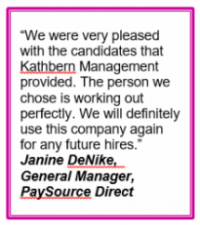Every manager needs to set priorities, not only for their organization but for themselves as well. The primary decision that overrides everything else is how to allocate time. Available time is fixed, and it is disappearing by the  second. What is the best use of a manager’s time? What tasks should the manager address themselves personally and which should they delegate to someone else? For those tasks or areas of responsibility that are assigned to others, what boundaries for decision-making should be established?
second. What is the best use of a manager’s time? What tasks should the manager address themselves personally and which should they delegate to someone else? For those tasks or areas of responsibility that are assigned to others, what boundaries for decision-making should be established?
Joseph J. Barnicke was the founder of J.J. Barnicke which grew to become the largest independent real estate company in Canada. In 1996, James Lake, J.J. Barnicke’s CFO, left the company’s offices and jumped to his death in front of a subway train. This was the final act in a drama stretching over several years in which Mr. Lake, although never having an “official” salary of more than $110,000 annually, managed to defraud the company of almost $20 million and paid himself between $2.0 and $5.0 million annually which he reported correctly to the Canada Revenue Agency and paid income taxes on.
James Lake was clearly given a lot of latitude in managing the affairs of the company and despite the company’s employment of a large public accounting firm as Auditor, nevertheless the fraud went on for some time without being detected. This is an example of too much unchecked responsibility being assigned to a single individual, although it is obvious that basic accounting controls and division of responsibilities would have prevented this scenario from playing out. Likely more than one party is at fault for either not making the correct recommendations for controls, for not accepting the recommendations or for sloppy auditing and careless management.
Another example of a type of negligence can be found with managers who trust their immediate management subordinates too much regarding how they manage THEIR people. It is not uncommon for a manager to present a  cooperative, positive, and amiable façade when dealing UP the organization chart but a tyrannical, negative, and soul-destroying persona when dealing DOWN the chart. One solution to prevent this type of two-faced charade is to employ the practice of “Manager Once Removed”. This technique is intended to provide direct contact between the manager’s immediate supervisor and the manager’s immediate subordinates. This can take many forms. In one example, the manager is responsible for the day-to-day management of their subordinates in the assignment of tasks but performance reviews, career direction and hiring/firing must be conducted with the full involvement of the manager’s supervisor. In this way, the immediate manager does not hold “life or death” power over their subordinates and, especially when multiple subordinates are involved, any disconnect with the immediate manager will eventually be communicated to the manager’s supervisor and can be dealt with which reduces the negligence in place.
cooperative, positive, and amiable façade when dealing UP the organization chart but a tyrannical, negative, and soul-destroying persona when dealing DOWN the chart. One solution to prevent this type of two-faced charade is to employ the practice of “Manager Once Removed”. This technique is intended to provide direct contact between the manager’s immediate supervisor and the manager’s immediate subordinates. This can take many forms. In one example, the manager is responsible for the day-to-day management of their subordinates in the assignment of tasks but performance reviews, career direction and hiring/firing must be conducted with the full involvement of the manager’s supervisor. In this way, the immediate manager does not hold “life or death” power over their subordinates and, especially when multiple subordinates are involved, any disconnect with the immediate manager will eventually be communicated to the manager’s supervisor and can be dealt with which reduces the negligence in place.
At the opposite end of the scale, but no less destructive, is the micromanaging manager whose goal is to control their employees as unthinking robots whose only responsibility is to implement the boss’ exact instructions down to the  last detail. Some employees will actually prefer this type of management because it requires very little mental energy and zero risk (providing that you follow the boss’ instructions to a “T” – and have good documentation as to what those instructions were). However, most employees do enjoy a certain degree of freedom to decide how to achieve a stated goal by using their own initiative and abilities. To keep these employees engaged, the managerial challenge is to establish the goals with enough boundaries to allow employees to attack problems with all of their creative abilities and yet not violate the boundaries that would expose the organization to various risks (legal, financial, political, etc.).
last detail. Some employees will actually prefer this type of management because it requires very little mental energy and zero risk (providing that you follow the boss’ instructions to a “T” – and have good documentation as to what those instructions were). However, most employees do enjoy a certain degree of freedom to decide how to achieve a stated goal by using their own initiative and abilities. To keep these employees engaged, the managerial challenge is to establish the goals with enough boundaries to allow employees to attack problems with all of their creative abilities and yet not violate the boundaries that would expose the organization to various risks (legal, financial, political, etc.).
Employees at different levels in an organization require different degrees of supervision and latitude. Even within the same level, differences in experience, maturity and personality will require the manager to fine-tune the degree to which any particular employee is provided with “freedom of movement” with the fail-safe provision that no one is ever provided with unfettered unaccountability outside of normal controls and audit.
Read More: Employee Turnover Is Killing Your Company – 7 Tips To Make It Stop
Situational Management
Most of the time, the best results are achieved by observation of a chain-of-command type approach where responsibilities are clearly defined and limits to authority are clearly understood. Some cross-over of the “manager once removed” approach helps to ensure that there is not an absolute firewall between each level.
 However, occasionally, under emergency conditions, a more senior manager will have good reason to override all reporting conventions and seize total control of the organization right to the front line. In 2006, during Operation Medusa, a Canadian-led offensive during the second Battle of Panjwaii of the war in Afghanistan, Major-General David Fraser1 was the leader of the NATO joint command.
However, occasionally, under emergency conditions, a more senior manager will have good reason to override all reporting conventions and seize total control of the organization right to the front line. In 2006, during Operation Medusa, a Canadian-led offensive during the second Battle of Panjwaii of the war in Afghanistan, Major-General David Fraser1 was the leader of the NATO joint command.
The goal of the operation was to establish government control over an area of Kandahar Province centered in the district of Panjwaii some 30 kilometres west of Kandahar city. At one point during the battle, a group of soldiers were surrounded by the Taliban and it appeared that they had no pathway of escape. The chain of command and the complexity of multiple NATO militaries involved made normal chain of command operations too slow, so General Fraser assumed total control of the situation and was in direct radio contact with both the trapped military personnel and air command resources that he could bring to bear in creating a means for these personnel to escape. Without his quick thinking, the outcome would have been very different. A tactical victory, the battle resulted in the deaths of 12 Canadian soldiers; five during the major combat operations, five in bombings, and two in a mortar/RPG attack during the reconstruction phase of the operation. Fourteen British military personnel were also killed when their plane crashed. Operation Medusa was at the time the most significant land battle ever undertaken by NATO.
As in all areas of management, balance and attention to the requirements of a specific situation or specific individuals will usually provide the best results.
___________________________________________
1David Fraser, Operation Medusa: The Furious Battle That Saved Afghanistan from the Taliban
Kathbern Management is an executive search firm based in Toronto, helping companies find the executives and senior managers who not only have the experience and credentials to fulfill their responsibilities, but also have the emotional and “fit” requirements that will enable them to be successful in a particular environment. We simplify the process and, through our deep research, are able to bring more and better candidates forward than would ever be possible through a do-it-yourself passive advertising campaign.
Contact us today for a free consultation about your key person search.

